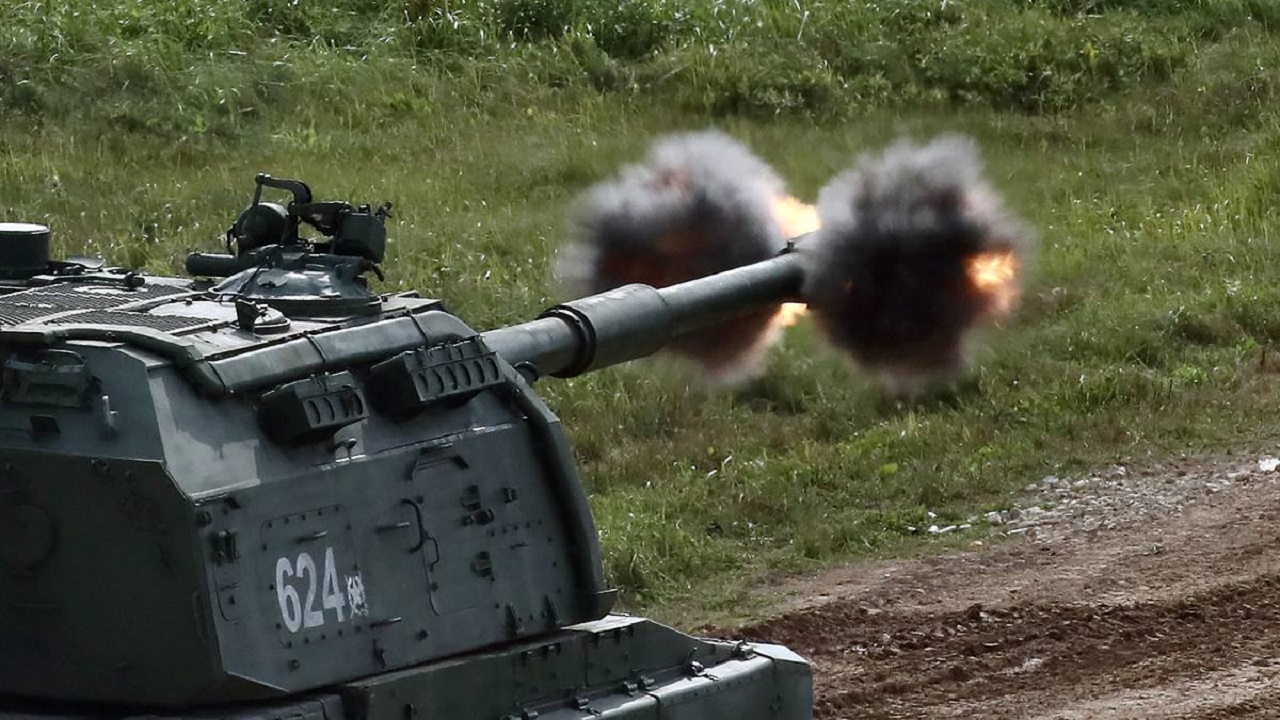Just how many troops will Putin lose in his disaster of a war in Ukraine?
Some say Russia has lost over 200,000 soldiers – both killed and wounded.
Others say Moscow has lost less. What are the best sources we can trust?
One thing is quite clear: we know social media will have limitless footage for analysts to study to get to the bottom of such questions.
Putin Can’t Watch: Footage Shows How Powerful Ukraine’s ‘Big Guns’ Can Be
Back in late April of this year, the Ukrainian Ministry of Defense released a 30-second video clip on social media highlighting the teamwork employed by a trained artillery crew on the front lines.
“We are all working together to win and drive the enemy out of our country. Watch these patrol officers @patrolpoliceua send ‘warm regards’ to the occupiers,” @DefenceU said via a tweet.
See the Weapon in Action
The “sizzle” video showed Ukrainian artillery crew loading and firing a 2A65 “Msta-B,” a Soviet-designed towed 152.4mm howitzer.
The weapon was first fielded with the Soviet Army in the late 1970s and is currently in use with a number of former Soviet republics, including Belarus, Georgia, Kazakhstan, Russia, Turkmenistan, and Ukraine – while Moscow has reportedly provided a number to Syria.
Accurate production numbers of the Msta-B are unknown, in part because it was never exported outside of the Soviet Union.
Open-source intelligence suggests around 2,000 units were produced. Ukraine reportedly had 130 in service at the start of the war, but it is unknown if any were lost in the fighting.
Countering the West
The origins of the howitzer date back to the Cold War, and it was designed for a potential war with NATO.
As Western artillery systems had made huge strides in the 1970s, Moscow attempted to keep up and launched a new program to develop a new towed howitzer to replace its aging 152mm D-20, as well as the older D-1 and ML-20 platforms that remained in second-line service.
It is mounted on a conventional split trail carriage and, when deployed in the firing position as seen in the recent video, rests on three points, the hydraulic circular firing jack under the forward part of the carriage and the two spades at the rear.
A crew of eight typically operates the gun – and the crew is partially protected by its gun shield.
It is a 152mm 47-caliber howitzer with a double baffle muzzle brake and sliding breech block and can fire the same rounds as the older D-20 and the self-propelled 2S3 Akatsiay.
The weapon has a maximum range of 24.7 km (15.3 miles) with standard high-explosive (HE) ammunition and 28.5 km (17.7 miles) with base bleed shells.
The 2A65 was designed for delivering all types of suppressive fire, including cluster munitions, and is even capable of firing nuclear artillery shells. A laser-guided munition, the Krasnopol, was also introduced for the targeting of armored vehicles, buildings, bunkers, fortifications, and warships.
We are all working together to win and drive the enemy out of our country.
Watch these patrol officers @patrolpoliceua send “warm regards” to the occupiers. pic.twitter.com/8B9bN4vjE6— Defense of Ukraine (@DefenceU) April 25, 2023
Despite the fact that the 2A64 Msta-B was developed for use against NATO, it wasn’t used in combat until the War in Donbas in 2014 but has since seen service in the Syrian Civil War.
The 2A64 is currently employed by both sides in the fighting in Ukraine, and last year reports circulated that Russia had been pounding Ukrainian positions with the weapon.
It would appear now that Ukraine is employing the weapon – along with the British-supplied M777 howitzer and its M982 Excalibur ordnance to strike back in the ongoing artillery duels in the Donbas region.
Author Experience and Expertise
A Senior Editor for 19FortyFive, Peter Suciu is a Michigan-based writer. He has contributed to more than four dozen magazines, newspapers, and websites with over 3,200 published pieces over a twenty-year career in journalism. He regularly writes about military hardware, firearms history, cybersecurity, politics, and international affairs. Peter is also a Contributing Writer for Forbes and Clearance Jobs. You can follow him on Twitter: @PeterSuciu.

